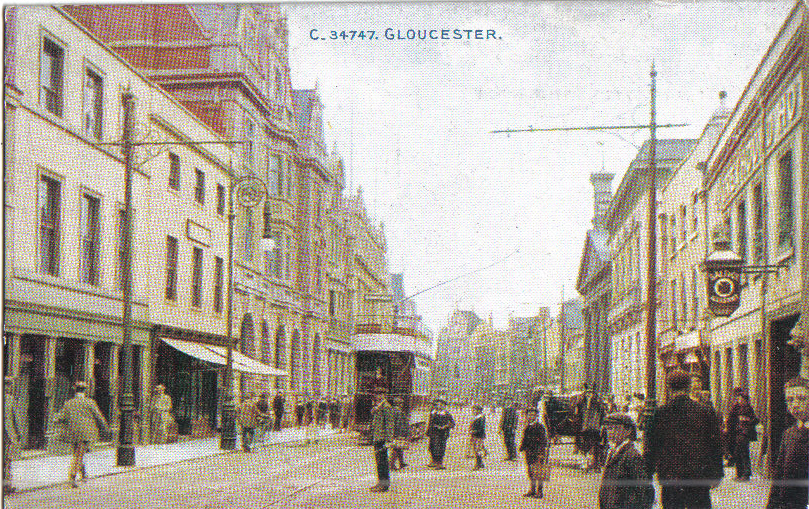Gloucester Corporation Tramways on:
[Wikipedia]
[Google]
[Amazon]
Gloucester Corporation Tramways operated an electric tramway service in
 The company operated tramways along the six main roads leading out of Gloucester. A portion of the Brockworth via
The company operated tramways along the six main roads leading out of Gloucester. A portion of the Brockworth via
Gloucester Corporation Transport.
{{Historic UK Trams Tram transport in England 1904 establishments in England Transport in Gloucester 3 ft 6 in gauge railways in England
Gloucester
Gloucester ( ) is a cathedral city and the county town of Gloucestershire in the South West of England. Gloucester lies on the River Severn, between the Cotswolds to the east and the Forest of Dean to the west, east of Monmouth and east ...
between 1904 and 1933.
History
Gloucester City Council
Gloucester City Council is the local authority for Gloucester, which is split into 18 wards, with a total of 39 councillors elected to serve on the City Council.
History
The district was formed from the County Borough of Gloucester on 1 April 1 ...
purchased the assets of the horse-drawn Gloucester Tramways Company
Gloucester Tramways Company operated a horse-drawn tramway service in Gloucester between 1879 and 1904.
History
In 1877, when The Gloucester Tramways Company submitted details of a system to the City Council. Gloucester Tramways Company was a ...
in 1902, with the intention of electrifying and extending the service. The horse tramway had been built to the 4' gauge, but the replacement electric service was built to the 3'6" gauge.
The contractor for the rebuilding was George Law of Kidderminster. Edgar Allen and Company
Edgar Allen and Company was a steel maker and engineer, which from the late 19th century was based at Imperial Steel Works, Tinsley, Sheffield, South Yorkshire. The site was bounded by Sheffield Road, Vulcan Road and the Sheffield District Railway ...
of the Imperial Steelworks and Yorkshire Steel and Engineering Works, Sheffield, provided the tramlines.
The electric service opened on 7 May 1904. Thirty tramcars were delivered in two batches from Brush Electrical Machines
Brush Electrical Machines is a manufacturer of electrical generators typically for gas turbine and steam turbine driven applications. The main office is based at Loughborough in Leicestershire, UK.
History
Charles Francis Brush, born in Eucl ...
of Loughborough. The livery was crimson lake and cream, but, during World War I, the livery changed to all-grey. This could have been due to a shortage of paint, or because the trams went to Brockworth Aerodrome, a sensitive military area. This all-grey livery lasted until the system's closure.
The tram depot was located off Bristol Road at its junction with Lysons Road at .
Routes
 The company operated tramways along the six main roads leading out of Gloucester. A portion of the Brockworth via
The company operated tramways along the six main roads leading out of Gloucester. A portion of the Brockworth via Hucclecote
Hucclecote is a suburb in Gloucestershire, United Kingdom, comprising a ward (population 8,826) in the City of Gloucester. It is located on the periphery of the city, between Barnwood and Brockworth, along Ermin Way, an old Roman road connectin ...
route was owned by Gloucestershire County Council
Gloucestershire County Council is a county council which administers the most strategic local government services in the non-metropolitan county of Gloucestershire, in the South West of England.
The council's principal functions are county road ...
.Great British Tramway Networks, Wingate H. Bett and John C. Gillham, Light Railway Transport League, London, 1944.
An extension from Churchdown Lane, Hucclecote, to the Victoria Inn, Brockworth, and into the new Brockworth Aerodrome took place during 1917, using recovered track from the little-used Westgate Street line. More track was laid into the Great Western Railway (GWR) sidings at Gloucester Docks, where much of the material was unloaded. Some of the trams were fitted out so that they acted as locomotives pulling several railway trucks, taking materials to the aerodrome. In the summers of 1922 to 1924, a passenger service ran to the Victoria Inn, transporting passengers to. what was then, the countryside. After this, the track extension, from Brockworth back to Churchdown Lane, was lifted.
Closure
As part of a programme of replacing the tramway services with buses, which had started in 1929, the final trams ran on 12 January 1933. In 1935, Gloucester City Council entered into an agreement with the Bristol Omnibus Co. to lease out its bus services. A joint committee administered these services. Bristol Omnibus and Gloucester Corporation both held their own Road Service Licences for the city (joint) routes. Until Stagecoach West took over the services in 1993, 35 Bristol/NBC/Western Travel buses always showed (CITY OF) GLOUCESTER on their sides, along with the city's Coat of Arms. In Bristol days, the bus depot was, and still is, in London Road, almost opposite Great Western Road.References
External links
Gloucester Corporation Transport.
{{Historic UK Trams Tram transport in England 1904 establishments in England Transport in Gloucester 3 ft 6 in gauge railways in England